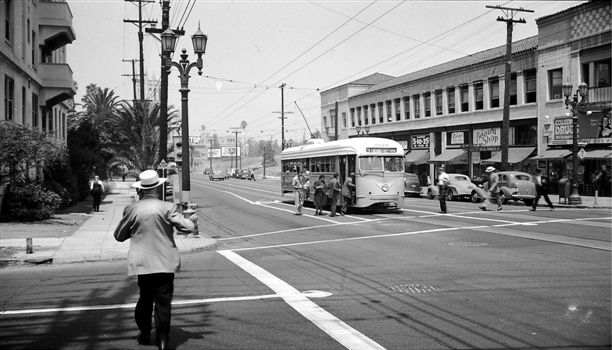LATL 3029 at 6th & Rampart, 1947: The “Rails to Rubber Revolution” is about to begin
By Ralph Cantos
Los Angeles Transit Lines PCC no. 3029 is seen here working the 3 Line, stopped at 6th & Rampart Blvd. in the Spring of 1947. Trolley Bus overhead is up and bus stop signs are in place.
In just a few months, transit history will be made here in Los Angeles for the second time, and its nothing to be proud of.
The PCC-operated 3 Line will be replaced by trolley buses. The 3 Line will go down in history as the second PCC-operated rail line in the United States to give way to rubber tire transit.
The dubious distinction of abandoning the FIRST rail line with PCCs in America goes to our own beloved Pacific Electric, who “pulled the plug” on the East Broadway line in Glendale in 1946 (it had been PCC operated since 1941). August 3, 1947 would see the PCC-operated 3 Line change over to Trolley Bus operation, for better or worse. This abandonment represented a terrible blow to the esteem of the PCC in its bid to rescue rail lines across America.
Not long after the 3 Line fell to rubber-tired transit, the dignity of PCCs took another major hit when the PCCs of San Diego Electric Railway gave way to buses in one fell swoop in 1948. That dastardly deed was perpetrated by trolley hater Jessie L. Hough, who had purchased the San Diego Electric Railway just months before, wasting no time in dispatching the near-new PCCs into dead storage, to await sale to anyone smart enough to snap them up. That same SOB would scuttle the PCCs on the Glendale-Burbank a few years later.
The “RAILS TO RUBBER REVOLUTION” had begun and it was going to get ugly before things would get better a half-century later.
Ralph Cantos Collection



While LATL management was anxious to remove rail lines in 1947, the City of Los Angeles was a major culprit in the abandonment of the “3” line. The city decided that the movement of traffic in the downtown area would be facilitated by making 5th and 6th streets one way. LATL would have had the expense of moving one track from 5th to 6th St., something they apparently did not want to finance.
I remember the changeover day. And I remember how LATL and all the LA newspapers reported “The great leap forward”. But, I do not remember where the trolley busses came from. I wonder……..
Great leap backward, more like.
The original 8000 class trolley buses were built for and delivered to the Key System in Oakland, also owned by National City Lines, LATL’s owners. The National City Lines management decided the trolley buses were needed more in Los Angeles and were shipped down and repainted in LATL colors.
The reason for the discontinuance of rail service on the LATL “3” line was that the city of Los Angeles converted 5th Street and 6th Street to one-way streets in August of 1947.
The 3 line used 5th Street in both directions between Central Ave. on the east and Beaudry Ave on the west.
When 6th Street went one-way it also affected the Pacific Electric. 6th Street was a portion of the Edendale Line. The Edendale Line and west on 6th from Central Ave to Figuroa St. then north on Figuroa to 2nd St, the west on 2nd Street to Glendale Blvd. near the subway exit.
After this abandonment the PE’s only connection to Western District was via the Airline and West Los Angeles.
I remember reading, in the newspaper, about hos LATL had to pave the PRoW that ran parallel to Wilton Place between 6th Street and 3rd Street in the middle of the night after the last PCC and before the first trolley bus.
Lamenting the demise of the LATL and Red Care is great, but, let’s see the numbers. The equipement was worn, track maintenance was eating them alive. The song – siren or other wise, of roads paid for with gas tax dollars was too good to pass up.
When 6th Street went one-way, PE had to reroute the Pasadena rail lines. Prior to August 1947 the two lines (Short Line and Oak Knoll) ran as a loop through LA. South on San Pedro Street, west on 6th Street and north on Main Street. After the change to 6th Street, the two Pasadena lines operated in and out via San Pedro Street and the viaduct.